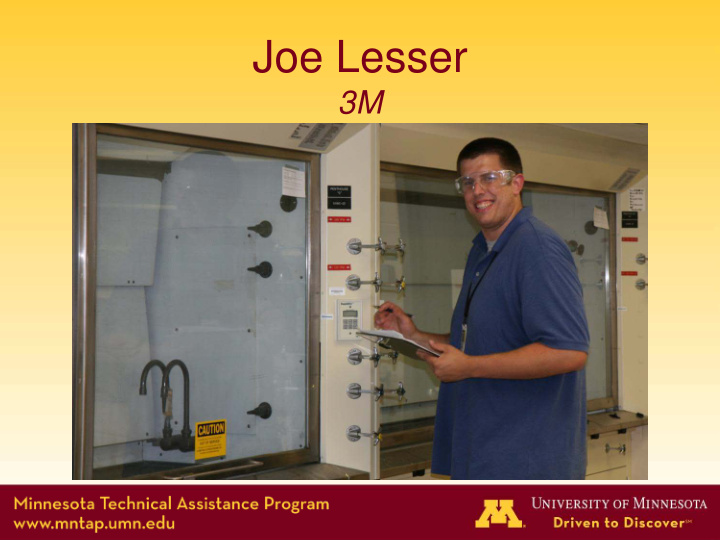



Joe Lesser 3M
“Sash-to-Save” 3M Joseph Lesser Advisor: Karl DeWahl
3M Overview • 76,000 employees • 56,000 products – adhesives, abrasives, laminates, electronic circuits and optical films • Operates in 60 countries • Products available in 200 countries • Sales of $23.1 billion in 2009
Motivations for Change • 3M Center has the highest energy cost of any 3M location. • 50% for HVAC in labs
Problem Background • Many labs have excess exhaust and wasted energy. – Fume hoods are always on – Fume hoods often underutilized
Possible Solutions Examined by 3M • Installing on/off switches • Decommission hoods when not in use • Installing Variable Air Volume Systems • Close Hood Sashes
Installing on/off switches • Pros – Employees can turn off the hoods • Cons – On/off switch may cause safety problems
Decommission fume hoods when not in use • Pros – Save energy when hoods are turned off – Potentially create leverage for upgrades • Cons – Too time consuming – Re-commissioned hoods continue to run inefficiently – Potential cost of upgrades
Installing Variable Air Volume Systems • Pros – Decreased energy consumption • Cons – Cost of installation • Divisions that are in charge of the labs have no incentive to update their ventilation system
Close Fume Hood Sashes when not in use • Pros – Decreases energy consumption – Implementation cost • Cons – Actually getting people to close their hoods when not in used
“Sash-to-Save” Program • Uses social marketing to encourage people to close their fume hood sashes when not in use.
Approach • Survey every fume hood at 3M Center – 1800 hoods total – 1300 for this project • Gather several pieces of information – Hood location – Vertical or horizontal? – An estimation of use • Never, Rarely, Some, or Frequently – Open or closed? • Enter all of that information into a database.
Approach (cont.) • Create “audit routes” – Roughly 80 routes total – Volunteer auditors check whether hoods are open or closed – To be done either before or after hours. – Should not take no longer than 15 minutes to complete – Each “audit route” will followed once every 2-3 weeks. – A database will analyze and distribute results
Audit Route Map
Approach (cont.) • Audit results will be communicated to lab occupants and their managers • A quarterly pizza party for any division in each building that has a closure rate of 95% or higher will be the incentive.
Results From Two Pilot Building
Long Term Benefits of “Sash-to-Save” • Almost $1 million in savings a year if hoods are closed on nights and weekends.
Immediate Benefits • When surveying, I would close every fume hood that was open. • This has energy saving potential • After a month, I preformed a spot check on a set of OPEN and “Rarely” or “Never” used fume hoods. • This set consisted of 138 hoods.
Spot Check Results Use Status % Closed Never 100.00% Rare 69.42% Total 73.19%
Immediate Benefits • Assumptions – $4 per cubic feet per minute (CFM) per year – Closing a fume hood decrease flow by 40% – To be conservative taking 50% of that total • Low end savings = $65,000/year • High end savings = $175,000/year
Personal Benefits • Learned simple ways in which a company can save energy and money • Learned new problem solving techniques • Had the opportunity to work for a great company that has provided me with a very valuable learning experience
Recommend
More recommend